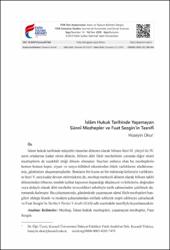| dc.contributor.author | Okur, Hüseyin | |
| dc.date.accessioned | 2019-12-31T07:28:18Z | |
| dc.date.available | 2019-12-31T07:28:18Z | |
| dc.date.issued | 12-2019 | en_US |
| dc.identifier.citation | OKUR, Hüseyin. "İslâm Hukuk Tarihinde Yaşamayan Sünnî Mezhepler ve Fuat Sezgin’in Tasnifi." FSM İlmî Araştırmalar İnsan ve Toplum Bilimleri Dergisi, 14 (2019): 399-434. | en_US |
| dc.identifier.uri | https://dergipark.org.tr/tr/pub/fsmia/issue/51096/667360 | |
| dc.identifier.uri | https://hdl.handle.net/11352/2996 | |
| dc.description.abstract | İslam hukuk tarihinde müçtehit imamlar dönemi olarak bilinen hicri II. yüzyıl ile IV. asrın ortalarına kadar süren dönem, bilinen dört fıkıh mezhebinin yanında diğer sünnî mezheplerin de teşekkül ettiği dönem olmuştur. Sayıları onlarca olan bu mezheplerin hemen hemen hepsi, siyasi ve sosyo-kültürel etkenlerden ötürü varlıklarını sürdürememiş, günümüze ulaşamamışlardır. Bunların bir kısmı az bir müntesip kitlesiyle varlıklarını hicri V. asra kadar devam ettirmişlerse de, mezhep merkezli dönem olarak bilinen taklit döneminden itibaren, mutlak içtihat kapısının kapandığı düşüncesi ve kitlelerin, doğrudan veya dolaylı olarak dört mezhebe teveccühleri sebebiyle tarih sahnesinden çekilmek durumunda kalmıştır. Bu çalışmamızda, günümüzde yaşamayan sünnî fıkıh mezhepleri hangileri olduğu klasik ve modern çalışmalardan istifade edilerek tespit edilmeye çalışılacak ve Fuat Sezgin’in Tarihu’t-Turâsi’l-Arabî (GAS) adlı eserindeki tasnifiyle kıyaslanacaktır. | en_US |
| dc.description.abstract | Between the 2nd and 4th centuries after hijrah, during the period in the history Islamic law known as the time of mujtahid scholars, there have been Sunni madhhabs other than the four schools of fiqh known today. Almost all of these madhhabs (sects), which have reached numbers as high as several dozen at that time, have failed to maintain their existence and reach our time due to political and sociocultural factors. Although a small number of these schools have been able to continue their existence with small numbers of followers until the 5th century after hijrah, from the period known as the madhhab-oriented imitation period, they began to withdraw from the stage of history due to the growth of the thought that absolute Islamic jurisprudence was no longer possible and due to the fact that masses of people had turned their favor towards the four madhhabs due to direct and indirect reasons. In this study, we will try to determine which madhhabs are the ones that have failed to maintain their existence by utilizing classical and modern works and comparing these findings to Fuat Sezgin’s classification in his work titled Tarihu’t-Turasi’l- Arabi (GAS). | en_US |
| dc.language.iso | tur | en_US |
| dc.publisher | FSM Vakıf Üniversitesi | en_US |
| dc.rights | info:eu-repo/semantics/openAccess | en_US |
| dc.subject | Mezhep | en_US |
| dc.subject | İslam hukuk mezhepleri | en_US |
| dc.subject | Yaşamayan mezhepler | en_US |
| dc.subject | Fuat Sezgin | en_US |
| dc.subject | Madhhab (sects) | en_US |
| dc.subject | Sunni fiqh schools of Islamic law | en_US |
| dc.subject | Discontinued madhhabs | en_US |
| dc.title | İslâm Hukuk Tarihinde Yaşamayan Sünnî Mezhepler ve Fuat Sezgin’in Tasnifi | en_US |
| dc.title.alternative | Sunni Schools of Fiqh in the History of Islamic Law That No Longer Exist and Fuat Sezgin’s Classification | en_US |
| dc.type | article | en_US |
| dc.contributor.department | FSM Vakıf Üniversitesi, Edebiyat Fakültesi | en_US |
| dc.relation.publicationcategory | Makale - Ulusal - Editör Denetimli Dergi | en_US |
| dc.contributor.institutionauthor | Okur, Hüseyin | |



















